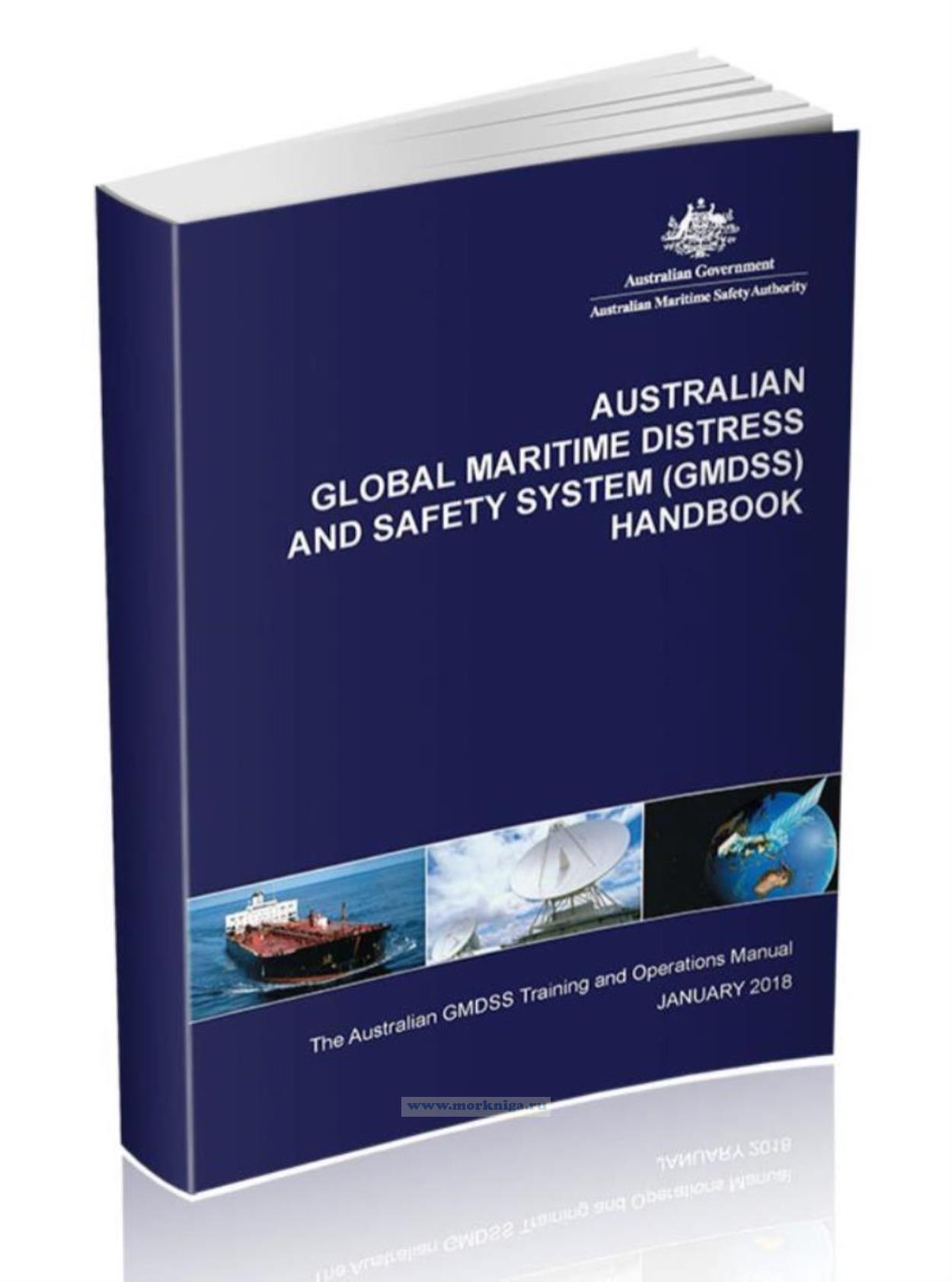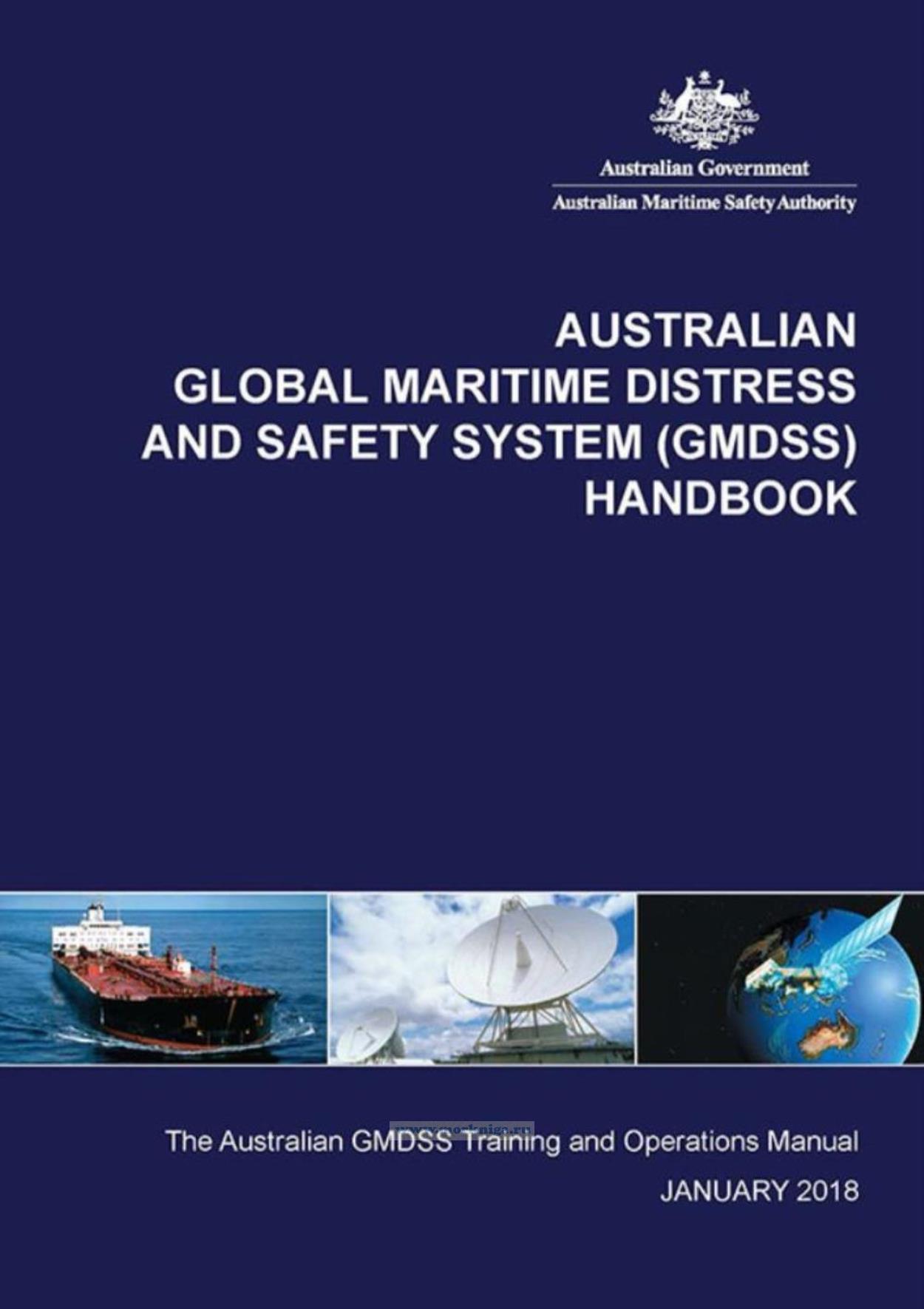Australian Global Maritime Distress and Safety System (GMDSS) Handbook/Австралийское руководство по глобальной морской системе связи при бедствии (ГМССБ)
Книга на английском языке.
This handbook has been produced by the Australian Maritime Safety Authority (AMSA), and is intended for use on ships that are:
- compulsorily equipped with GMDSS radiocommunication installations in accordance with the requirements of the International Convention for the Safety of Life at Sea Convention 1974 (SOLAS) and Commonwealth or State government marine legislation
- voluntarily equipped with GMDSS radiocommunication installations.
It is the recommended textbook for candidates wishing to qualify for the Australian GMDSS General Operator’s Certifcate of Profciency.
Contents
Foreword
1 An Introduction to the Global Maritime Distress and Safety System
1.1 History
1.2 Function requirements
1.3 Basic concept of the GMDSS
1.4 Areas of operation under the GMDSS
1.5 The GMDSS Master Plan
1.6 Introduction of GMDSS
1.7 Functional requirements
2 General Principles and Features of the Maritime Mobile Service
2.1 Priorities of communications in the Maritime Mobile Service
2.2 Types of stations in the Maritime Mobile Service
2.3 Frequencies and frequency bands
2.4 Frequencies allocated to the maritime services
2.5 Characteristics of frequencies
2.6 Component parts of marine radio equipment
2.7 Modes of communication
3 Requirements of Maritime Mobile and Satellite Services
3.1 Functional requirements of ship stations
3.2 Equipment carriage requirements for SOLAS ships
3.3 Equipment carriage requirements for Non-SOLAS ships
3.4 Types of alerting from GMDSS ships
3.5 Watchkeeping on distress frequencies
3.6 Sources of energy of ship stations
3.7 Means of ensuring availability of ship station equipment
3.8 Operator qualifications
3.9 Licences, safety radio certificates, inspection and surveys
3.10 Ship station identification
4 Introduction to the Inmarsat system and the Maritime Mobile Satellite Service
4.1 Maritime satellite communications
4.2 Types of stations in the Maritime Mobile Satellite Service
5 GMDSS Digital Selective Calling Equipment and Systems
5.1 Introduction
5.2 Purpose
5.3 DSC shipborne equipment
5.4 Call formats
5.5 Maritime Mobile Service Identity (MMSI)
5.6 Types of DSC calls and how they are used
5.7 Distress Alert attemps
5.8 Frequency or channel for ongoing communications
5.9 Cancellation of inadvertent distress alerts
6 Narrow Band Direct Printing Equipment and Systems
6.1 Introduction
6.2 Modes of transmission
6.3 GMDSS applications
6.4 NBDP equipment
7 GMDSS Inmarsat equipment
7.1 Inmarsat-B/Fleet77 SESs
7.2 Inmarsat-C SESs
7.3 Inmarsat EGC receivers
8 Long Range Identification and Tracking (LRIT)
8.1 LRIT conformance testing
9 GMDSS MF, HF and VHF equipment
9.1 MF/HF transceivers
9.2 VHF transceivers
9.3 Watchkeeping receivers
10 Emergency Position Indicating Radio Beacons (EPIRBS)
10.1 EPIRBS
10.2 The Cospas-Sarsat system
10.3 Australian and New Zealand Cospas-Sarsat ground segment
10.4 Vessel identification and beacon registration
10.5 Homing by search aircraft
10.6 EPIRB requirements for GMDSS ships
10.7 406 MHz EPIRB operation
10.8 Inadvertent activation of 406 MHz EPIRBS
10.9 Servicing and testing of 406 MHz EPIRBS
10.10 Termination of Inmarsat -E/E+ EPIRBS
10.11 VHF DSC EPIRBS
10.12 EPIRBS fitted with AIS burst transmitters
11 Shipborne Automatic Identification System (AIS)
11.1 What Is AIS?
11.2 System description
11.3 How it works
11.4 Functionality and capability
11.5 Message types and formats
11.6 Display requirements
11.7 AIS benefits
11.8 AIS errors and drawbacks
11.9 Destination code to be used in AIS
11.10 Contribution of AIS
11.11 Annual testing of AIS
12 Survival craft radio equipment
12.1 Search and Rescue Radar Transponders (SARTS)
12.2 AIS-Search and Rescue Transmitters (AIS-SARTS)
12.3 Portable survival craft VHF radiotelephone apparatus
12.4 Maritime survivor locating systems (Man Overboard devices)
13 The Navtex system
13.1 Introduction
13.2 Shipboard equipment
14 Search and Rescue (SAR) Operations
14.1 Shore based SAR network
14.2 The IAMSAR manual
14.3 On-Scene communications
14.4 Locating and homing signals
15 Ship Reporting Systems
15.1 MASTREP
15.2 The REEFREP system
15.3 The AMVER system
15.4 Other ship reporting systems
16 GMDSS Distress Urgency and Safety Communications Procedures
16.1 General
16.2 General Inmarsat distress, urgency and safety procedures
16.3 Fleet77 SESs
16.4 Inmarsat 505 emergency calling (Fleetbroadband)
16.5 Inmarsat-C SESs
16.6 General DSC distress, urgency and safety procedures
16.7 MF/VHF DSC and radiotelephone distress urgency and safety procedures
16.8 HF DSC procedures
16.9 Australian DSC, NBDP and R/T distress and safety shore facilities
16.10 Radiotelephony communications with non-GMDSS ship stations
16.11 Protection of distress frequencies
16.12 Medical transports
16.13 Radiomedical advice
16.14 Maritime assistance services
17 Routine Testing
17.1 General requirements
17.2 VHF DSC systems
17.3 MF/HF DSC systems
17.4 Inmarsat-C equipment
17.5 Emergency radio batteries
17.6 Mhz EPIRBS
17.7 SARTs
17.8 AIS-SARTs
17.9 Summary of routine testing
18 Battery Maintenance
18.1 Battery requirements
18.2 Types of batteries
18.3 Lead-Acid batteries
18.4 Care and maintenance of Lead-Acid batteries
18.5 Alkaline batteries
18.6 Battery hazards
19 Equipment Maintenance
19.1 Antenna systems
19.2 Radio equipment
20 Routine Communications Procedures
20.1 Radio records
20.2 Service documents
20.3 General routine communications procedures
20.4 Radio Telex services
20.5 Traffic charges
20.6 Time signals
20.7 Sample GMDSS Radio Log page
Appendices
1. Frequencies for use by GMDSS Ship Stations
2. Promulgation of Maritime Safety Information
3. Phonetic Alphabet and Figure Code
4. Standard Marine Communication Phrases
5. Maritime Identification Digits (MIDS)
6. Australian GMDSS GOC Course
7. Reserve Source of Energy
8. Guidelines for Operational Use of Shipborne AIS
9. Forms
10. Table of Transmitting Frequencies in the VHF Maritime Mobile Band
11. Routine Testing (Extract From GMDSS Radio Log)
12. Operation of Marine Radar for SART Detection
13. Information on the Display of AIS-SART, MMOB and EPRIB Devices
14. Inmarsat-C Short Address Codes (SACs)
15. Glossary of Terms
16. References
Figures
Figure 1 The Global Maritime Distress and Safety System (GMDSS) - simplified overview
Figure 2 ITU radio frequency bands and GMDSS usage
Figure 3 Simplex operation
Figure 4 Duplex operation
Figure 5 Propagation of ground waves and sky waves
Figure 6 Various forms of amplitude modulation
Figure 7 Australian GMDSS terrestrial network
Figure 8 AMSA HF DSC Network
Figure 9 Equipment required for Australian GMDSS vessels (without an onboard maintainer)
Figure 10 Inmarsat global coverage applicable to GMDSS
Figure 11 Typical Inmarsat Fleet 77 installation
Figure 12 Typical Inmarsat-C system
Figure 13 Basic concept of the Inmarsat Enhanced Group Call system
Figure 14 Classes of mobile earth stations
Figure 15 International SafetyNET Service system concept
Figure 16 Doppler curve
Figure 17 Doppler mirror positions
Figure 18 Basic concept of the Cospas-Sarsat system
Figure 19 LEOSAR and GEOSAR satellites
Figure 20 MHz LEOSAR Satellite Coverage and LEOLUTs
Figure 21 MHz GEOSAR Satellite Coverage and GEOLUTs
Figure 22 Principles of SOTDMA
Figure 23 Screen capture of AIS data
Figure 24 SART Radar Display
Figure 25 A typical AIS-SART
Figure 26 AIS-SART indication on chart display
Figure 27 AIS-SART transmit burst sequence in Active Mode
Figure 28 Maritime survivor locating device (Man Overboard Device) using AIS and VHF DSC
Figure 29 Format of NAVTEX Message
Figure 30 NAVAREAS of the World-Wide Navigational Warning Service (WWNWS)
Figure 31 Action on receipt of a MF or VHF DSC distress alert
Figure 32 Action on receipt of an HF DSC distress alert
Figure 33 Typical Uninterruptible Power Supplies
Figure 34 Sample of GMDSS Radio Log page
Figure 35 Areas for Coastal Navigation Warnings on SafetyNET (POR and IOR Satellites)
Figure 36 Forecast areas for high seas
Tables
Table 1 Frequencies for DSC watchkeeping
Table 2 Inmarsat terminal numbering
Table 3 DSC distress and safety frequencies
Table 4 ITU Symbols for DSC messages
Table 5 Australian MMSI formats currently in use
Table 6 Commonly used manual commands
Table 7 Ocean region codes
Table 8 Types of AIS stations and MMSI format
Table 9 AIS Message IDs
Table 10 Summary of routine testing - equipment
Table 11 Summary of routine testing - survival craft
Table 12 Summary of routine testing - reserve power
Table 13 Summary of routine testing - communications equipment
Table 14 Distress, urgency, safety and calling frequencies
Table 15 Schedule of Australian SafetyNET weather bulletins
Table 16 Phonetic Alphabet
Table 17 Figure Codes

